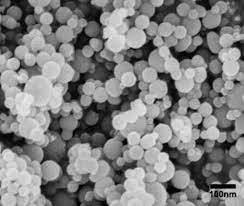
Aluminium Nanoparticles For Solar Cell
Aluminium Nanoparticles Improved thermoelectric properties of Aluminum Zinc Oxide (AZO) thin films
deposited by radio frequency (RF) and pulsed Direct Current (DC) magnetron sputtering at room temperature
are reported. In both techniques films were deposited using sintered and non-sintered targets produced from
nano-powders. It is confirmed that both the Al doping concentration and film thickness control the
thermoelectric, optical and structural properties of these films.
SOLAR CELL SENSOR Delafossite CuAlO2 belongs to a family of transparent conducting oxides (TCOs) – oxides
with low electrical resistivity and high visual light transparency – that show promise in multiple applications
including: liquid crystal displays, touch screens, gas sensors, thermoelectric devices, solar cells, dilute magnetic
semiconductors, light-emitting diodes, etc. CuAlO2 nanoparticles have also been used as thermo-catalysts in the
thermal photo-catalytic reactions for the evolution of hydrogen gas from water splitting. p–n junction
photovoltaic using CuAlO2 and In2O3, respectively, would allow visible light to pass through the cell while
producing electricity via the absorption of ultraviolet radiation.
Aluminium Nanoparticles has a layered crystal structure with Cu atoms between AlO2 layers forming O–Cu–O
pillars CuAlO2 has indirect and direct band gaps of 1.2 and 3.6 eV respectively, high transparency (80%) in the
visible region, and high light-to-electricity conversion efficiencies in solar cells . Photocurrents ranging from 0.02
mA/cm2 to 0.08 mA/cm2 have been observed when CuAlO2 nanoparticles (300 nm) were used as the
photocathode materials in p-type DSSCs, while delafossite CuGaO2 nanoplates produced comparatively high
photocurrents (0.384 mA/cm2) in the region of visible light using polypyridyl Co3+/2+(dtb-bpy) as the
electrolyte and the organic P1 dye Higher cathodic photocurrents (Jsc = 0.954 mA/cm2 under AM1.5 sun) were
observed in p-type dye sensitized solar cells (DSSCs) fabricated using these CuAlO2 nanoparticles compared to
the previous reports on delafossite CuBO2 (B = Al, Ga) nanoparticles. Enhanced current efficiency in these solar
cells is attributed to the nano-sized particles and narrow particle size distributions of nanocrystalline delafossite
Aluminium Nanoparticles thermoelectric properties of Aluminum Zinc Oxide (AZO) thin films deposited by
radio frequency(RF) and pulsed Direct Current (DC) magnetron sputtering at room temperature are reported. In
bothtechniques films were deposited using sintered and non sintered targets produced from nano-powders. It is
confirmed that both the Al doping concentration and film thickness control the thermoelectric, optical and
structural properties of these films. An efficient application of thermoelectric (TE) materials in devices requires
materials with high Seebeck coefficients (S ¼DV/DT), low thermal conductivity (k), and low resistivity (r) to attain
a large gure of merit (ZT ¼ S2T/kr). By nanostructuring materials the ZT value has improved to over 1 at 300 K,
taking Bi2Te2/Sb2Te2 superlattices (ZT > 2) and n-type PbSeTe (ZT ¼ 1.5) materials as examples.
TE applications it has mainly been explored with bulk dimensions and with different dopants: Zn1_xMxO, AZO if
M ¼ Al and GZO if M ¼ Ga,5 Zn1_(x+y)GaxInyO (x + y ¼ 0.007)6 or ZnAlO/In– ZnAlO quantum well multilayers.
Although this power output power is small for most applications, it is already comparable to full devices
comprising 100 thin lm thermocouples of Sb2Te3/Bi2Te3, also with planar geometry, which for DT ¼ 20 K have a
maximum power output of 7 nW.35 By connecting this n-type thermoelectric element with a compatible p-type
element, such as Cr : V2O5 20 and using an appropriate combination of series and parallel interconnections
between the TE elements it will be possible to design devices with higher output powers to meet the needs of
low power TE module applications.
Enhanced Ionic Liquids (NEILs) for Concentrated Solar Power (CSP)
Aluminium Nanoparticles Enhanced Ionic Liquids (NEILs) were synthesized by dispersing aluminum
oxide(Al2O3) Nanoparticles in 1-butyl-3-methylimidazolium bis {(trifluoromethyl) sulfonyl}imide, ([C4mim]
[NTf2]) ionic liquids (ILs). Concentrated Solar Power (CSP) is one of the developing alternative energy
technology, where mirrors or lenses are used to concentrate sunlight from a large area and are stored in a
collector filled with heat transfer fluid (HTF). Later on the energy of those HTF is used to produce steam for
power generation. Commonly used HTF such as Therminol VP-1 (eutectic mixture of biphenyl and diphenyl
oxide), thermal oil, and molten salt have low decomposition temperature and high melting point, which are
affecting the energy storage capacity and reducing the overall system efficiency, resulting in an increase of the
operating cost. Therefore, there is an acute need for the new energy-efficient HTFIonic liquids (ILs) are a class of
molten salt, which has melting point below 100 _C, high thermal stability, and negligible vapour pressure.
Aluminium Nanoparticles
These properties make them as a potential candidate for CSP applications over the currently used HTF addition,
nanofluids, which are defined as dispersion of metallic (Cu, Ag, and Au) or non-metallic (Al2O3, CuO, TiO2)
particles with one dimension less than 100 nmM in a base liquid, have great attraction due to their enhanced
thermophysical properties and enhanced ththeir potential applicability as cooling media for high heat
generating Melectronic device, nuclear plant, automobile industry. These enhanced heat transfer properties of
nanofluids encourage the researchers to combine these two (nanoparticles and ionic liquids) growing interests,
forming the Nanoparticle Enhanced Ionic Liquids (NEILs) by dispersing small amounts of nanoparticles into base
ILs. The practical applications of NEILs are as heat transfer fluids; and can be used for heat exchange in chemical
plants, absorption cooling cycle systems, and solar thermal power generationermal performance.
